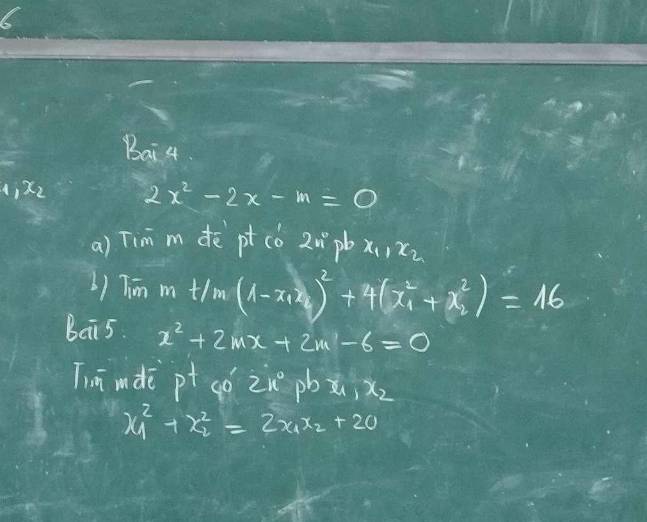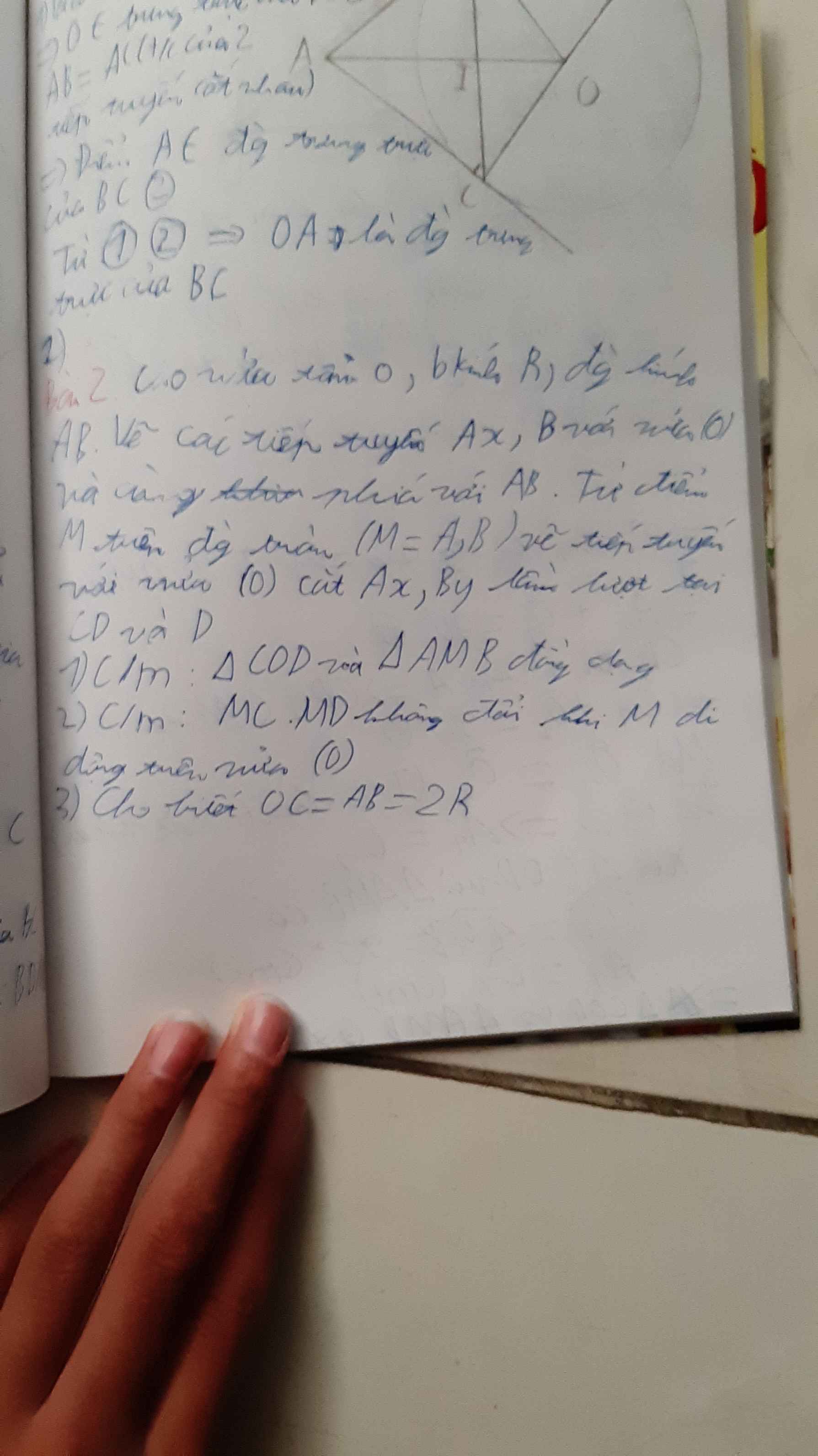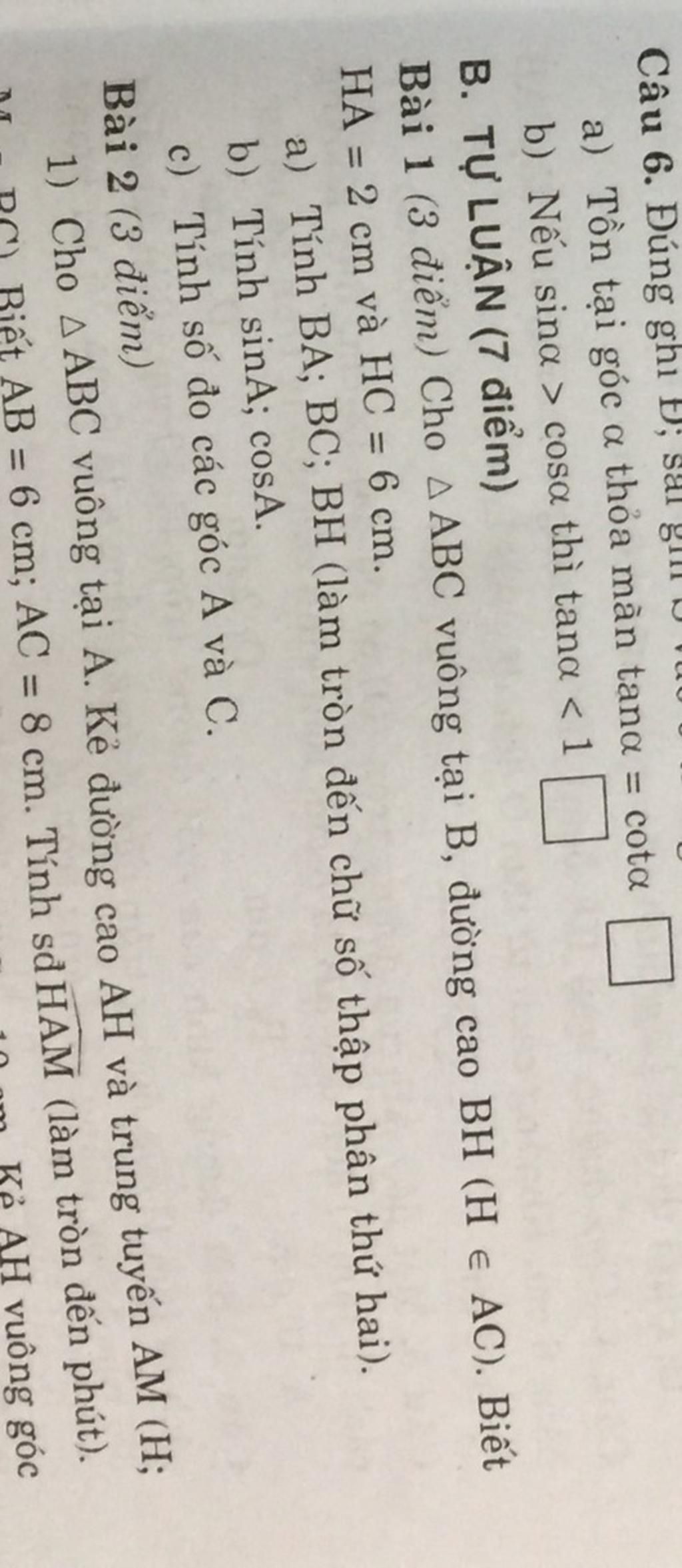
Hãy nhập câu hỏi của bạn vào đây, nếu là tài khoản VIP, bạn sẽ được ưu tiên trả lời.


\(D=\dfrac{2\sqrt{x}+1}{\sqrt{x}-3}=\dfrac{2\left(\sqrt{x}-3\right)+7}{\sqrt{x}-3}=2+\dfrac{7}{\sqrt{x}-3}\left(x\ge0;x\ne9\right)\)
Để \(D\) nguyên thì \(2+\dfrac{7}{\sqrt{x}-3}\) nguyên
\(\Rightarrow \dfrac{7}{\sqrt x-3}\) nguyên
\(\Rightarrow7⋮\sqrt{x}-3\)
\(\Rightarrow\sqrt{x}-3\inƯ\left(7\right)\)
\(\Rightarrow\sqrt{x}-3\in\left\{1;7;-1;-7\right\}\)
\(\Rightarrow\sqrt{x}\in\left\{4;10;2;-3\right\}\) mà \(\sqrt{x}\ge0\)
\(\Rightarrow\sqrt{x}\in\left\{4;10;2\right\}\)
\(\Rightarrow x\in\left\{16;100;4\right\}\left(tm.đk.x.nguyên\right)\)
Kết hợp với điều kiện, ta được: \(x\in\left\{4;16;100\right\}\)
\(D=\dfrac{2\sqrt[]{x}+1}{\sqrt[]{x}-3}\in Z\left(x\ge0;x\ne9\right)\)
\(\Leftrightarrow2\sqrt[]{x}+1⋮\sqrt[]{x}-3\)
\(\Leftrightarrow2\sqrt[]{x}+1-2\left(\sqrt[]{x}-3\right)⋮\sqrt[]{x}-3\)
\(\Leftrightarrow2\sqrt[]{x}+1-2\sqrt[]{x}+6⋮\sqrt[]{x}-3\)
\(\Leftrightarrow7⋮\sqrt[]{x}-3\)
\(\Leftrightarrow\sqrt[]{x}-3\in U\left(7\right)=\left\{-1;1;-7;7\right\}\)
\(\Leftrightarrow x\in\left\{4;16;100\right\}\)

A = \(\dfrac{4\sqrt{x}+9}{2\sqrt{x}+1}\)
Mà \(4\sqrt{x}+9>0\)
\(2\sqrt{x}+1>0\)
=> A > 0
A = \(\dfrac{2\left(2\sqrt{x}+1\right)+7}{2\sqrt{x}+1}\) = \(2+\dfrac{7}{2\sqrt{x}+1}\)
Mà \(2\sqrt{x}+1\ge1< =>\dfrac{7}{2\sqrt{x}+1}\le7\)
<=> \(A\le9\)
<=> 0 < A \(\le9\)
Mà A thuộc Z
<=> A \(\in\){1;2;3;4;5;6;7;8;9}
Đến đây bn thay A vào để tìm x nhé
A = \(\dfrac{2\left(2\sqrt{x}+1\right)+7}{2\sqrt{x}+1}=2+\dfrac{7}{2\sqrt{x}+1}\)
Mà \(2\sqrt{x}+1>0< =>\dfrac{7}{2\sqrt{x}+1}>0\)
<=> A > 2
Có \(2\sqrt{x}+1\ge1< =>\dfrac{7}{2\sqrt{x}+1}\le7\)
<=> \(A\le9\)
<=> 2 < A \(\le9\)
Mà A thuộc Z
<=> \(A\in\left\{3;4;5;6;7;8;9\right\}\)
Đến đây bn thay A vào để tìm x nhé

A = \(\dfrac{6\sqrt{x}+8}{3\sqrt{x}+2}=2+\dfrac{4}{3\sqrt{x}+2}\)
Có \(3\sqrt{x}+2>0< =>\dfrac{4}{3\sqrt{x}+2}>0\) <=> A > 2
Có: \(3\sqrt{x}+2\ge2< =>\dfrac{4}{3\sqrt{x}+2}\le2\) <=> A \(\le4\)
<=> 2 < A \(\le4\)
Mà A nguyên
<=> \(\left[{}\begin{matrix}A=3\\A=4\end{matrix}\right.\)
TH1: A = 3
<=> \(\dfrac{4}{3\sqrt{x}+2}=1\)
<=> \(3\sqrt{x}+2=4< =>x=\dfrac{4}{9}\)
TH2: A = 4
<=> \(\dfrac{4}{3\sqrt{x}+2}=2< =>3\sqrt{x}+2=2< =>x=0\)

Bài 5:
\(x^2+2mx+2m-6=0\)
\(\text{Δ}=\left(2m\right)^2-4\left(2m-6\right)\)
\(=4m^2-8m+24\)
\(=4m^2-8m+4+20\)
\(=\left(2m-2\right)^2+20>=20>0\forall m\)
=>Phương trình luôn có hai nghiệm phân biệt
Theo Vi-et, ta có:
\(\left\{{}\begin{matrix}x_1+x_2=-\dfrac{b}{a}=\dfrac{-2m}{1}=-2m\\x_1x_2=\dfrac{c}{a}=\dfrac{2m-6}{1}=2m-6\end{matrix}\right.\)
\(x_1^2+x_2^2=2x_1x_2+20\)
=>\(\left(x_1+x_2\right)^2-2x_1x_2-2x_1x_2=20\)
=>\(\left(-2m\right)^2-4\left(2m-6\right)=20\)
=>\(4m^2-8m+24-20=0\)
=>\(4m^2-8m+4=0\)
=>\(\left(2m-2\right)^2=0\)
=>2m-2=0
=>2m=2
=>m=1(nhận)
Câu 4:
a: \(2x^2-2x-m=0\)
\(\text{Δ}=\left(-2\right)^2-4\cdot2\cdot\left(-m\right)\)
\(=4+8m\)
Để phương trình có hai nghiệm phân biệt thì 8m+4>0
=>8m>-4
=>\(m>-\dfrac{1}{2}\)
b: Theo Vi-et, ta có:
\(\left\{{}\begin{matrix}x_1+x_2=\dfrac{-b}{a}=\dfrac{-\left(-2\right)}{2}=\dfrac{2}{2}=1\\x_1x_2=\dfrac{c}{a}=\dfrac{-m}{2}\end{matrix}\right.\)
\(\left(1-x_1x_2\right)^2+4\cdot\left(x_1^2+x_2^2\right)=16\)
=>\(\left(1+\dfrac{m}{2}\right)^2+4\cdot\left[\left(x_1+x_2\right)^2-2x_1x_2\right]=16\)
=>\(\left(\dfrac{m+2}{2}\right)^2+4\left[1^2-2\cdot\dfrac{-m}{2}\right]=16\)
=>\(\dfrac{1}{4}\left(m^2+4m+4\right)+4\left(1+m\right)=16\)
=>\(\dfrac{1}{4}m^2+m+1+4+4m-16=0\)
=>\(\dfrac{1}{4}m^2+5m-11=0\)
=>\(m^2+20m-44=0\)
=>(m+22)(m-2)=0
=>\(\left[{}\begin{matrix}m+22=0\\m-2=0\end{matrix}\right.\Leftrightarrow\left[{}\begin{matrix}m=-22\left(loại\right)\\m=2\left(nhận\right)\end{matrix}\right.\)
5.
\(\Delta'=1+2m\)
a.
Phương trình có 2 nghiệm pb khi:
\(1+2m>0\Rightarrow m>-\dfrac{1}{2}\)
b.
Khi pt có 2 nghiệm, theo hệ thức Viet: \(\left\{{}\begin{matrix}x_1+x_2=1\\x_1x_2=-\dfrac{m}{2}\end{matrix}\right.\)
\(\left(1-x_1x_2\right)^2+4\left(x_1^2+x_2^2\right)=16\)
\(\Leftrightarrow\left(1-x_1x_2\right)^2+4\left(x_1+x_2\right)^2-8x_1x_2=16\)
\(\Leftrightarrow\left(1+\dfrac{m}{2}\right)^2+4.1^2+4m=16\)
\(\Leftrightarrow\dfrac{m^2}{4}+5m-11=0\Rightarrow\left[{}\begin{matrix}m=2\\m=-22< -\dfrac{1}{2}\left(loại\right)\end{matrix}\right.\)
5.
\(\Delta'=m^2-\left(2m-6\right)=\left(m-1\right)^2+5>0;\forall m\)
Pt luôn có 2 nghiệm pb
Theo hệ thức Viet: \(\left\{{}\begin{matrix}x_1+x_2=-2m\\x_1x_2=2m-6\end{matrix}\right.\)
\(x_1^2+x_2^2=2x_1x_2+20\)
\(\Leftrightarrow\left(x_1+x_2\right)^2=4x_1x_2+20\)
\(\Leftrightarrow4m^2=4\left(2m-6\right)+20\)
\(\Leftrightarrow m^2-2m+1=0\Rightarrow m=1\)


a) Áp dụng hệ thức lượng trong tam giác vuông vào ΔABC vuông tại B có BH là đường cao ứng với cạnh huyền AC, ta được:
\(BH^2=HA\cdot HC\)
\(\Leftrightarrow BH^2=2\cdot6=12\)
hay \(BH=2\sqrt{3}\left(cm\right)\)
Áp dụng định lí Pytago vào ΔBHA vuông tại H, ta được:
\(BA^2=BH^2+HA^2\)
\(\Leftrightarrow AB^2=\left(2\sqrt{3}\right)^2+2^2=12+4=16\)
hay BA=4(cm)
Áp dụng định lí Pytago vào ΔABC vuông tại B, ta được:
\(AC^2=BA^2+BC^2\)
\(\Leftrightarrow BC^2=8^2-4^2=48\)
hay \(BC=4\sqrt{3}\left(cm\right)\)
b) Xét ΔABC vuông tại B có
\(\sin\widehat{A}=\dfrac{BC}{CA}=\dfrac{4\sqrt{3}}{8}=\dfrac{\sqrt{3}}{2}\)
\(\cos\widehat{A}=\dfrac{BA}{CA}=\dfrac{4}{8}=\dfrac{1}{2}\)





